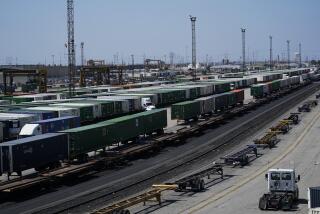Regulators OK weaker version of air pollution program for Southern California

A view of downtown Los Angeles on a smoggy afternoon in 2006.
Southern California air quality regulators turned aside tough new pollution control measures on Friday in favor of an industry-backed alternative plan that will make slower progress toward cleaning smog from the nation’s most polluted region.
The South Coast Air Quality Management District board voted 7-5 in favor of a plan that industry groups argued would allow them to curtail emissions more gradually and with fewer costs.
The measure would reduce the cap on smog-forming emissions from the region’s largest facilities, including refineries, power plants and factories, from 26.5 tons of nitrogen oxides a day today to 14.5 tons by 2022.
Air district staff had proposed a steeper, faster plan that would have cut the cap on nitrogen oxides by an additional two tons a per day to a level of 12.5 tons over the same period.
“Those two tons of pollution may not mean much on paper, but out here it translates to more emergency room visits, more respiratory illnesses, and our community can’t take much more of that,” said Allen Hernandez, a Sierra Club organizer in the smoggy Inland Empire.
NEWSLETTER: Get the day’s top headlines from Times Editor Davan Maharaj >>
Air quality board chairman William A. Burke said the adopted measures were a compromise but better than taking no action. Oil interests fought hard to weaken the staff proposal, arguing that it would force refineries and other facilities to spend billions upgrading pollution controls.
To achieve the reductions, regulators are relying on a decades-old cap-and-trade program that establishes a limit on emissions and allocates each facility pollution credits. Operations whose emissions are cleaner than what is required can sell their credits to those whose emissions exceed the limits.
Under the program, air quality regulators gradually reduce the number of credits available, forcing all industries to reduce their pollution over time. At issue Friday was how fast the air quality board would reduce the number of credits — and by how much.
The air district’s staff had recommended 14 tons in reductions by 2022, at a faster pace, and environmental groups had advocated for even steeper cuts.
By adopting a slower and more modest 12-ton cut, the board’s action is expected to further delay the installation of emissions controls at oil refineries and other big pollution sources.
The decision followed hours of emotional testimony at a public hearing in Diamond Bar. Environmentalists and community groups urged to board to adopt agency staff’s proposal and take swift action to clean the air and ease asthma and other smog-triggered health problems across a four-county region of 17 million people.
Air district staff warned that the industry-supported measure was not supported by the agency’s analysis and may not be legally defensible in California, which requires that any cap-and-trade programs achieve the same pollution reductions that could be reached with direct limits on emissions, an approach followed elsewhere in the state.
“The governing board decided to just disregard the law in California and adopt a really weak smog regulation,” said Adrian Martinez, a lawyer for the environmental law nonprofit Earthjustice. “It placed the interests of the oil industry over people’s health.”
The decision is a serious setback to the South Coast air district’s attempt to overhaul its long-criticized Regional Clean Air Incentives Market, or RECLAIM, adopted in 1993 as one of the nation’s earliest cap-and-trade programs. The nitrogen oxides it regulates are gases that disperse through the region to contribute to the formation of ozone and other lung-damaging air pollutants.
The program was targeted for an overhaul because it has not achieved the level of emissions reductions promised. For years, an oversupply of credits has made it easier for oil refineries and other big industries to buy rights to emit smog-forming pollution than to spend money on better controls.
As a result, Southern California refineries have lagged in installing pollution-scrubbing equipment that is commonplace in the Bay Area and other regions where emissions are regulated directly. Nitrogen oxide emissions from the 275 facilities regulated under the program have remained flat in recent years, even as the region has missed federal deadlines to clean the air.
The cuts in emissions credits adopted Friday would apply to 56 of the region’s largest air pollution sources and would fall most heavily on the region’s six major oil refineries in El Segundo, Torrance, Carson and Wilmington.
In a prepared statement, Western States Petroleum Assn. President Catherine Reheis-Boyd welcomed the decision, saying “we are pleased the South Coast Air Quality Management District board listened carefully to the concerns.”
The measures, more than two years in the making, are the South Coast air district’s most significant effort to curb smog in a decade. Officials said they are essential for Southern California to reduce air pollution to meet federal health standards for ozone and fine particulate matter.
For more air quality and environment news, follow @tonybarboza
ALSO
In surreal scene, reporters swarm Redlands home rented by shooters
Why the FBI just declared the San Bernardino shooting a terrorism probe
Shooter sent Islamic State a Facebook post just as San Bernardino attack began, source says
More to Read
Sign up for Essential California
The most important California stories and recommendations in your inbox every morning.
You may occasionally receive promotional content from the Los Angeles Times.











